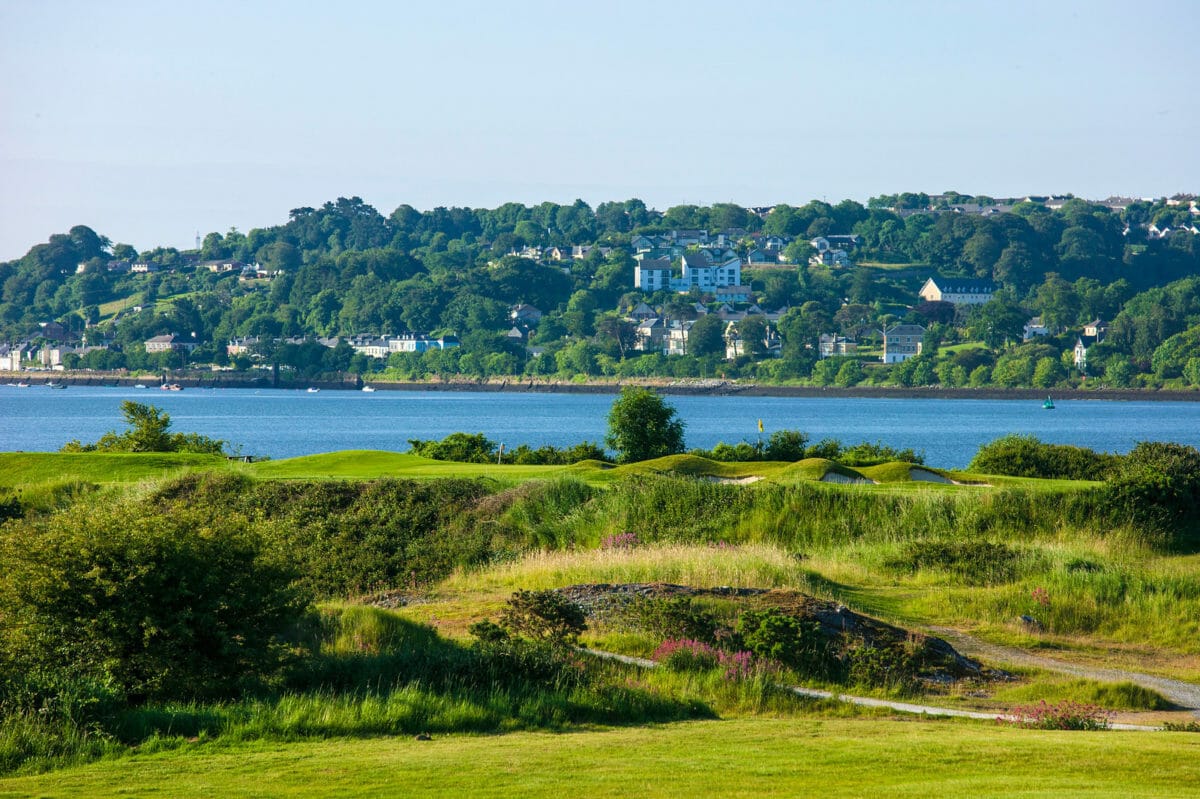Cork Golf Club is famous for many things, with the Limestone Quarry emphatically leading the way. It created a remarkable setting for golf holes that were first played over while the quarry was still in operation. This was back in the late 1890s. Later, Harry Vardon (1911) extended the club to 18 holes, before Dr. Alister MacKenzie (1925) rerouted the course, added three new holes, created new greens and added sand-filled bunkers – quite the novelty back then. And all the while the quarry remained at the heart of the track.
The quarry dates back to the late 1700s and produced thousands of tons of limestone every year. It was used in the construction of national public buildings, including Cork’s City Hall, but it was shipped much further afield and as far away as New York.
For the past 100 years it has been a unique and stunning feature of a revered course. That said, in recent years it had become less visible. Nature had taken hold and trees, gorse and brambles hid the natural rock walls in several places.
Over the past 18 months the club has carried out a large amount of clearing work. This has opened up the course, including the quarry. It was all prompted by the arrival of Cork GC’s new Course Superintendent – Simon O’Hara – who came from Fota Island.
New blood; new ideas. And so it was to prove as gorse and trees were removed, while new trees were introduced. The quarry, now cleared and on full display, will also see a new wetlands area shy of the par three 7th green. Appropriately, as I was being given a tour of the course, a duck flew in and landed on the water. The first of many, no doubt.
You might think that clearing away gorse and trees wouldn’t make that much of a difference, but play through the stretch of quarry holes and you will realise how wrong that assumption is – the quarry walls now create an amphitheatre setting for holes 8, 9 and 10, with the 11th playing above and around it. That is not the whole quarry because the 2nd tees off from a height down to a fairway that streaks straight towards Cork Harbour. Your tee shot is played from on top of another limestone wall. And then there are holes 4 to 7 which also owe their origins to the quarries.
By taking away vast swathes of gorse, views of the course and the bare stone are revealed. Perhaps one of the most interesting removals is the gorse in front of the 5th tee (by the old disused kiln). This area was known as ‘Shufflers’ after the caddies who had to go shuffling through it to find their golfer’s balls. A thankless and uncomfortable task. That’s no longer a problem on this timeless hole and today’s tee shot shows off more of the fairway as well as a round tower across the water. The Index 1 4th, which drives over the Harbour’s waters, has seen a dense flank of gorse uprooted along the right of the fairway. It makes the estuary much more visible and even makes the hole more daunting as you are now completely exposed.
As part of the same network of quarry holes, there has been considerable clearing work done in front of the 10th tee, where a new tee box has been added. Once again, it opens up your view of the hole. Once again, with all those pits and limestone hollows right in front of you, it makes your tee shot more intimidating.
Trees – particularly Lodgepole Pines – have been removed in numbers too, probably 400-500 in the past decade. Not all have been deliberate as storm damage has played its part but those deliberately targeted and felled give the course and holes more space. The short par four 3rd, for example, has seen a bunch of trees and brush cleared from the right hand side. This opens up the space so that golfers see more of the estuary as they approach the green. The removal, both here and elsewhere, is also designed to speed up play.
The work is therefore for both practical and aesthetic reasons.
As some trees have been removed, so others have been introduced; between 200 and 300 young Scots Pines have appeared in specific areas around the course as these are more in keeping with the terrain.
The difference this work has made is substantial. Yes, there are some minor design and infrastructure changes* in the mix, too, but the focus is the clearance of vegetation to enhance the overall feel of the course. Certainly, in that famous stretch of holes that runs from the 4th to the 11th, Cork Golf Club has achieved its objective. The limestone rock is there for everyone to see and it ensures sharper and cleaner lines to holes and the course in general.
* Design and infrastructure changes
Buggy paths have been enhanced in places (e.g. the 2nd) and remain on the ‘To Do’ list, while a new wall fronts the 15th tee. Two bunkers that were added to the 18th fairway in the major 2013 rebunkering programme have been removed. To facilitate maintenance, most of the bunkers’ shoulders have also been softened. More interestingly, the 5th hole will lose the gentle ridge of mounding behind the green to introduce an ‘infinity green’ effect.
And what about the other highly beneficial element of limestone: drainage. The club’s free-draining terrain makes it playable all year round… and this was complemented by 2013’s comprehensive rebunkering programme, which used Sportsbond. Cork Golf Club was the first club in Ireland to use the technology.
This soil, those bunkers, that quarry have helped Cork to become a golf club for the ages. And yet it begs the question: what kind of course is it?
Is it a Parkland? That seems too simple. What about shoreline? Sure, three holes cling to the Harbour’s waters. Could there be a flourish of heathland? No, there isn’t any heathland (Ireland has only a few courses boasting such terrain) but there’s something about the quarry holes that makes you think there might be. The free draining soil, perhaps. Whatever it is, it is a very fine mix of holes.
Then again, there is a simpler way to look at it and it is this: this course was designed by Dr Alister MacKenzie. Such heritage is a key attraction. It gives the course a global stamp of acclaim and the number of visiting American golfers has risen over the past two years. Getting the MacKenzie name out there – not surprisingly – continues to be important… as does his design philosophy.
“The chief object of every golf architect and green keeper worth his salt is to imitate the beauties of nature so closely as to make his work indistinguishable from nature itself.” Alister MacKenzie.
The great architect’s approach to design was distinctive to say the least – just spend a few hours watching the Masters, this April, and you’ll understand why. The rebunkering and upgrade programme introduced by Martin Hawtree was designed to take the course back to its MacKenzie roots. It was an important step. After all, why wouldn’t you embrace one of the greatest designers of his generation… or any generation for that matter.
The Course
When you play Cork Golf Club there are certain things to appreciate. For one, Cork’s greatness does not stem from the four holes visible from the clubhouse (1, 14, 15 and 18). If anything, these are the tame parkland holes. Cork’s brilliance lies elsewhere… along the edges of Cork Harbour, in the quarry and over more tumbling terrain. Cork is sneaky like that – it fools you time and again. Add to that the excellent levels of maintenance, which sees greens in superb shape, and you have a course of sheer class.
The first thing golfers need to know about Cork is that it is a driver’s course. Measuring 6,533 yards (middle white tees) the 12 par fours fall between 289 and 440 yards, so there’s plenty of variety to be enjoyed from the tee box. Yes, it is a strong test of golf but swinging the driver is always a joy. The second thing is that the greens (and green complexes) will wreak havoc if you don’t attack them from the right angle. And finally, Cork changes style and pace constantly which means you need to pay attention.
The first such change comes when you walk up to the par five 2nd tee and see the fairway streaking towards Cork Harbour below. As you tee up for one of the best drives of the day, you’ll appreciate that the course has switched gears in the blink of an eye. This is also when you’ll fully appreciate the intimidating bunkers, both from the tee and on the approach. You will feel squeezed as you negotiate your way between them.
The 4th hole signals another change in direction as you drive over a curling beach to a rising fairway. It is the par five 5th, however, which many will remember most. The old kiln is in front of you and now clearly visible, thanks to the disappearance of Shufflers, while the fairway beckons away to the left before straightening up with water all along the right. The view of the green from the tee is tantalising; it sits on a narrow spit of land jutting out into the harbour’s dark waters.
The 6th starts the most distinctive run of quarry holes and the rock walls add a level of isolation and menace. You’re already in 5th gear and these MacKenzie holes simply purr along. The par four 8th has the full quarry backdrop and falls between two exquisite par threes, both possessing devilishly undulating greens (a MacKenzie signature) before the 10th steers you back parallel to the water.
“The stretch of holes from the 4th to the 10th compare with any golf course I have played,” said Billy Caspar, in 2013. That’s not too shabby an endorsement from the winner of 48 PGA Tour events and three Majors.
Further strong parkland holes follow and while the significant elevation changes on the down-and-up 16th and the tilting fairway 17th prove captivating, the 12th remains a favourite. At only 320 yards, it is a short sharp dogleg right which requires a precise drive between the trees before you face a short approach to a well raised three-tiered green, perched above a nest of bunkers.
Yes, Cork is a driver’s course, for sure, and one that has now been opened up even further with the charm and threat of the limestone quarry fully restored. The combination of location, heritage, beauty and the recent works all make this Little Island club as magnetic as ever.
Check out the club’s brand new website at www.corkgolfclub.ie


























Leave a comment